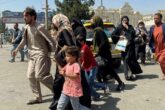January 08, 2015
Defend, Defect, or Desert?
The Future of the Afghan Security Forces
The Afghan National Security Forces (ANSF) are soon to become the center of gravity for security in Afghanistan. In September 2014, U.S. and Afghan leaders signed a Bilateral Security Agreement (BSA) and have since announced that approximately 10,800 U.S. service members will remain in Afghanistan as the formal portion of the international combat mission ends.2 The size of the U.S. support mission in Afghanistan is scheduled to decrease even further. Earlier this year, President Obama stated that the United States would drawdown to a “normal embassy presence” by the end of 2016.3 In the coming months, Afghanistan will depend on increasingly independent Afghan security forces to fight a tough insurgency—one that is perhaps even as strong as it was four years ago during the height of U.S. and coalition operations.4
In order to achieve its strategic goal to deny safe haven to Al-Qaeda and its affiliates, the United States must continue to provide support to the ANSF. To be sure, Afghanistan is only one part of a larger U.S. mission to disrupt and destroy the Al-Qaeda network. Both the 2010 National Security Strategy and President Obama’s comments this year highlight that the shift towards an advise and assist mission in Afghanistan will afford the United States greater “flexibility to fulfill different missions” in the rest of the world.5 However, while refocusing to other parts of the globe, the United States must remain committed to sustaining the ANSF. Without functioning security forces, Afghanistan will be unable to defend even the most fundamental population areas and transportation routes. This may undermine the ability of U.S. special operations forces to conduct counterterrorism operations—and will almost certainly deny the United States a host country partner in disrupting the Al-Qaeda network in Afghanistan. Although Afghanistan and Iraq are vastly different places, the crumbling of Iraqi security forces in northern and western Iraq this summer demonstrates what the collapse of military forces means for state stability and the devastating impact that it can have on U.S. counterterrorism strategy.6 Similar developments in the ANSF would be strategically and politically disastrous.
The good news is that the Afghan security forces are not doomed. Over the past decade, the NATO Training Mission-Afghanistan (NTM-A) and Combined Security Transition Command-Afghanistan (CSTC-A) have manned, trained, and equipped an ANSF that is 350,000 troops strong – composed of the Afghan National Army (which includes the Afghan Air Force), the Afghan National Police, and the Afghan Local Police.7 The quality of forces has improved as well. As of September 2014, International Security Assistance Force (ISAF) trainers assessed 33 of 40 ANSF units to be either “capable” or “fully capable.”8 Moreover, the ANSF are now “in the lead” for security operations across the country and are scheduled to be fully responsible for this mission by the end of 2014.9
The rate of attrition in the Afghan National Army and the fiscal costs associated with Afghan security forces highlight future sustainment challenges.
At the same time, the ANSF will face serious challenges going forward. Throughout Afghan history, national military units have been notoriously difficult to build. Once formed, they have been even more troublesome to control. At several points in Afghan history, Afghan military units have disintegrated or defected to adversary forces in the face of military confrontation or political crisis – and senior military officials in Afghanistan have launched coups against civilian leaders. Today, many of the current indicators for sustainability of the ANSF are troubling. Two interrelated factors, the rate of attrition in the Afghan National Army and the fiscal costs associated with Afghan security forces, highlight future sustainment challenges. Going forward, the ANSF will need continued support in key areas, as requested by newly elected Afghan President Ashraf Ghani earlier this fall.10 Without it, the ANSF stands little chance of holding together.
Things Fall Apart: Historical Challenges in Building an Afghan Military
The history of military development in Afghanistan brings to mind three key themes. First, Afghan political leaders have consistently struggled to build professional military units. While Afghan culture valorizes bravery in combat, a centralized military contradicts traditional societal preference for local political autonomy.11 For centuries, Afghans have mobilized, both politically and militarily, along sub-national affiliations, such as tribe, sub-tribe, or qawm. The ability to mobilize beyond locality has fluctuated based on factors including, but not limited to, the stature, influence, wealth, or foreign support of a group’s leader. Accordingly, the recruitment and training of a national military parallels the broader challenge of establishing political legitimacy in Afghanistan. Over the course of the nineteenth and twentieth centuries, Afghan political leaders attempted to consolidate a central Afghan state with varying degrees of success.12 The military was one important component of this state-building effort, but simultaneously alienated and provoked local leaders, leading to resistance and revolt.13
Second, once established, the loyalty of professional military units has been difficult to maintain, leading to coups, mass desertions, and defections to enemy forces during political crises or military confrontations. Professional military forces in Afghanistan have not always remained loyal to political leadership.14 For example, despite its steady growth and professionalization during the mid-twentieth century, the Afghan military initiated a series of coups in the 1970’s – first to overthrow the monarchy and later to emplace (and purge) a communist regime.15 Simultaneously, Afghan military units throughout the country crumbled during the early part of Afghan communist rule. The rise of the communist PDPA and subsequent Soviet invasion of the country prompted vehement resentment throughout the country, triggering a parallel fragmentation of the military.16 Numerous military revolts broke out; some military units disintegrated altogether.17 Other times, Afghan officers undermined the institution by coordinating efforts with rebel forces from inside.18 Between 1979 and 1983, the number of Afghan soldiers plummeted from 120,000 to 30,000, later prompting hasty drives for recruitment.19 The Soviet military attempted to rebuild the Afghan security forces, but continued to struggle to maintain loyalty, as mujahedeen attempted to infiltrate the Afghan military.20
Third, since the founding of Afghanistan in 1747, the government has relied on external funding to sustain central military units. The experience of Soviet withdrawal from Afghanistan highlights some important lessons about the necessity for sustained financial support – as well as the inability of the regime to survive without it. When the Soviet Union withdrew forces in 1989, the PDPA military did not immediately fall apart. On the contrary, troops proved capable in battle against massed mujahedeen formations attempting to seize key terrain, as seen in the 1989 assault on Jalalabdad. The Afghan President, Mohammad Najibullah, successfully held the military together for nearly four years, largely due to continued access to Soviet assistance in the form of arms and money. The Soviets supplied Kabul with airplanes, tanks, armored personnel carriers, anti-aircraft weapons, rocket launchers, SCUD missiles, and fuel – totaling some $3 billion per year.21
However, with the collapse of the Soviet Union in 1991, financial support to the Afghan regime ceased. By April 1992, the PDPA regime collapsed and the military followed suit. Once Kabul lacked the resources to sustain its security forces, key commanders simply chose to change sides. As one prominent historian describes, “the PDPA regime was less defeated militarily than reorganized as its components defected to various mujahedeen factions.”22 This is not to say that the PDPA military had survived solely because of the financial support afforded it. One key policy change that Najibullah adopted was to expand the size of the force, more heavily relying upon rural militias and coopting local patronage networks through the distribution of weapons and funds.23 All the same, without external funding, the PDPA military could not hold and the government lost control over these rural militias. As a result, Afghanistan was thrown into a period characterized by internal violence and political chaos that facilitated, at least in part, the Taliban’s rise to power.
The full report is available online.
More from CNAS
-
A Failure to Plan: Examining the Biden Administration’s Preparation for the Afghanistan Withdrawal
Afghanistan, Iraq, and Vietnam. One failure is a horrible accident; two failures are a tragic coincidence; three failures are a disturbing trend that shows the U.S. government...
By Christopher D. Kolenda
-
Against All Odds
Eighteen months after taking power, the Taliban is intensifying its repression of Afghan civil society and cracking down on the rights and freedoms of all Afghans, especially ...
By Lisa Curtis, Annie Pforzheimer & Jan Mohammad Jahid
-
To Help Afghanistan, Engage Its Political Opposition
The effort to help Afghans shape a better alternative should begin now....
By Richard Fontaine & Lisa Curtis
-
International Community Must Do More to Protect Human Rights in Afghanistan
Human rights in Afghanistan, especially those of women and girls, have deteriorated sharply during the first year of Taliban rule. The very real prospect of losing a generatio...
By Lisa Curtis, Annie Pforzheimer & Jan Mohammad Jahid




